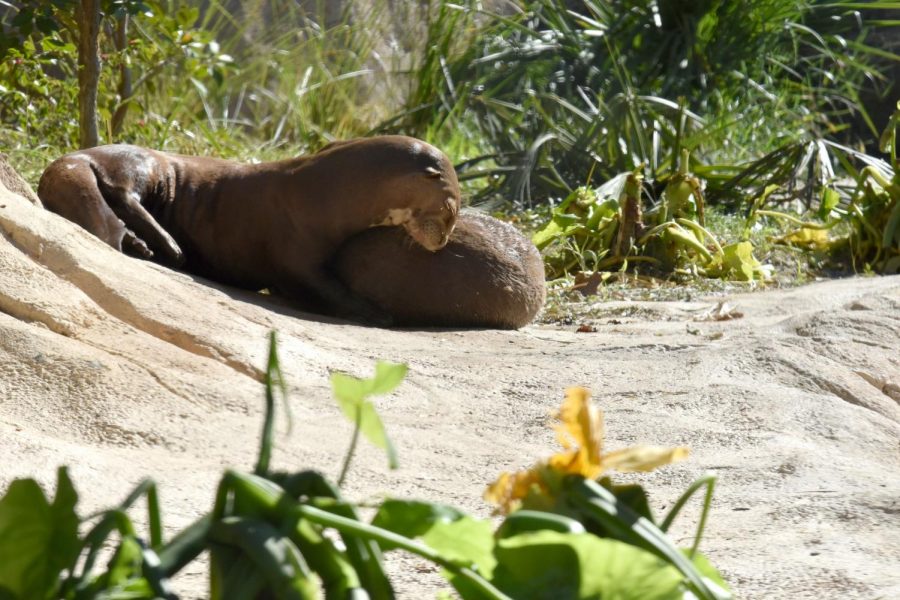New exhibit showcases diversity in Pantanal
Two of the giant river otters relax together in the Pantanal exhibit at the Houston Zoo. There are 51 species and 150 animals in the new exhibit.
December 19, 2020
Even in the midst of a pandemic and after a two-month closure because of COVID, the Houston Zoo opened the nation’s first Pantanal exhibit this fall. The new Pantanal exhibit took four years of planning and construction, and the project had to be delayed due to the pandemic.
“We were going to open [the Pantanal exhibit] in the spring,” Kevin Hodge, the zoo’s general curator, said. “As [the pandemic] started coming up, the construction timeline had to be adjusted.”
The Pantanal is a flooded wetland area in South America known for its biodiversity. The zoo does a lot of conservation work in the Pantanal.
“We really wanted to do something a little bit different and something that aligned better with our conservation work in the wild,” Hodge said. “So we chose the Pantanal.”
The zoo works with several projects to help wildlife in the Pantanal. Every admission ticket purchased helps the zoo’s partners. The zoo is working with the armadillo project, the lowland tapir project initiative, and other organizations to save wildlife in the Pantanal. The zoo even had their curator of birds, Chris Holmes, travel to Colombia to teach husbandry courses on taking care of the blue-billed curassow.
“We have projects that are working to save giant river otters and jaguars in the wild through eco-tourism,” Hodge said.
The Houston Zoo made sure to show the Pantanal’s diversity in its newest exhibit. The exhibit has 51 species. Some of the animals featured in this exhibit are golden lion tamarins, howler monkeys, red-rumped agouti, tapir, giant anteaters, capybara, as well as many birds including the blue-billed curassow, oropendola, and the blue-throated macaw. The new exhibit also features a jaguar, an anaconda and orange-spotted stingrays.
“We have giant river otters,” Hodge said. “That’s the first time we have ever had giant river otters at the zoo.”
The new exhibit includes new viewing options for the visitors. Visitors can see the golden lion tamarins and the howler monkey through the anaconda habitat. Some habitats feature multiple animals coexisting like they would in the wild. The Pantanal exhibit features a walk-in aviary, an area where birds are housed. Guests can see birds flying above them or look at the nests the oropendolas are building.
The design of the exhibit overall adds a new twist to the experience.
“It looks like [the golden lion tamarins and the anaconda] are in the same exhibit or the same habitat, but they’re not,” Hodge said. “They are safely in their own spaces, but it is pretty cool to see.”
Not only is this the nation’s first Pantanal exhibit, but it also exhibits progressive habitats for its animals. The habitats for the animals in the Pantanal exhibit are complex and were created with the animals’ wellbeing in mind. The zoo ensured the animals got large multi-use habitats with areas they can go to not be seen.
“We are a new zoo,” Hodge said. “A lot of times people think of zoos and they think of animals like in rows of cages, and that’s not the truth anymore.”
For those interested in visiting, the Houston Zoo requires that guests wear masks and order tickets online before arriving due to the pandemic. In areas that get crowded easily the zoo is ensuring social distancing by cueing small groups of people into areas like the Pantanal exhibit and the reptile house.
“It is a good time to come and check out the Pantanal area; plan to spend some time there,” Hodge said. “Don’t just run through quickly. You need to go spend a little time and see all the animals that you can see, and you will see them doing natural things like you would see the animals doing in the wild.”









